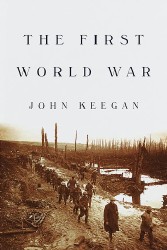CRUFFLER.COM
presents
Book
Review, October 1999:
| The
First World War
by John Keegan Alfred A. Knopf, Inc., 1999 Hardcover, 475 pages ISBN 0375400524 |
 |
Cruffling, or the collecting of firearms classified as curios and/or relics has, perforce, a historical bent to it. This is not in the least due to the fact that many of the firearms classified as curios or relics obtain that classification because of their association with some historical figure or event. However, this author is convinced that in order to see beauty in both form and function in a fifty to seventy-five year old firearm bearing the scars and mars of hard use in the hands of soldiers in far off lands and times, within the cruffler there must beat the heart of an historian. The old firearms that crufflers collect and cherish allow us to connect with history in a very real, tangible and rarified manner that is usually reserved for the likes of museum curators, historic park rangers, archaeologists, and academics. In this way, the cruffler becomes intimately entwined, and not a little responsible for, the preservation of history and heritage.
However, all this becomes little more than fluff and poppycock if the aspiring collector remains insulated from an understanding of the driving forces which fired the crucibles in which the old warhorses were forged. Such an understanding however, is often difficult to obtain, owing to the tortuous paths that history, as a record of human endeavor, and the even more twisted attempts to articulate history, have taken. Once in a great while, though, an historian with a gift for writing comes onto the scene and graces us with a volume that offers rare insight and clarity into a particular period. John Keegan is such an historian, and his latest work, The First World War is such a volume.
The history of the origins and prosecution of World War One is at best confusing. Countless treaties, national grudges dating back hundreds of years, arms races spawned by new and burgeoning technologies all conspire to muddy the waters. Keegan steps dauntlessly into this mess and in a most able manner presents the reader with easily comprehended and readily assimilated bits of clarity that join together to form a comprehensive and complete record of not only the events, but their causes and reasons as well.
The reader is introduced to the men who orchestrated the history of the world in the late 19th and early 20th centuries. Keegan takes the names from the realm of ink and paper and gives them flesh, blood, form and substance. The reader is priveleged to know Foch, Joffre, Haig, French, Brusilov, Samsonov, von Hotzendorff, Ludendorff, Moltke, von Falkenhayn, Enver Pasha, Mustafa Kemal Pasha, and Pershing in a most personal manner that only serves to make more clear their actions and the effect those actions had on the conduct of the war.
Keegan describes the movement and combat of divisions, corps, armies and groups of armies in a unique manner which makes them as understandable and as intimate as those of companies, platoons, squads, and individual soldiers. Importantly, the reader is not insulated from the costs of the war through the use of numbing statistics. Rather, the terrible losses are brought across in human terms which cannot help but stir all but the most callow readers.
It is worthwhile to comment on Mr. Keegan's writing style. All to often in this electronic information age, we seem to lose concern for the manner in which information is conveyed, so long as the essential message gets across. While this is no doubt a fine philosophy for computers, it robs the human reader of the joy of language. This author is happy to report that Mr. Keegan does not subscribe to this philosophy. His writing is a joy to read. His words and sentences are structured beautifully and flow easily. In fact, Mr. Keegan's writing style alone is justification for the cost of the book.
However, Keegan's beautiful prose is not the foremost gift the book brings. The book's beauty lies in the understanding, the utter comprehension with which the reader comes away. Many will have, for the first time, a good understanding of why the First World War happened, the nature of the battles that took place during the conflict, the effects the conflict had on Europe and the world, and how the war fits into the fabric of history. For the firearms collector, those old Mausers, Enfields, Springfields, and maybe a Lebel or two will take on a new, more significant meaning.
The philosopher George Santayana once remarked that "Those who do not remember the past are condemned to repeat it." With vigilant and articulate guardians of the past like Mr. Keegan, and the works that he produces, we may all escape Santanyana's dire prediction.
The
First World War is available from Amazon.com. Click on the image
to order:

|
|